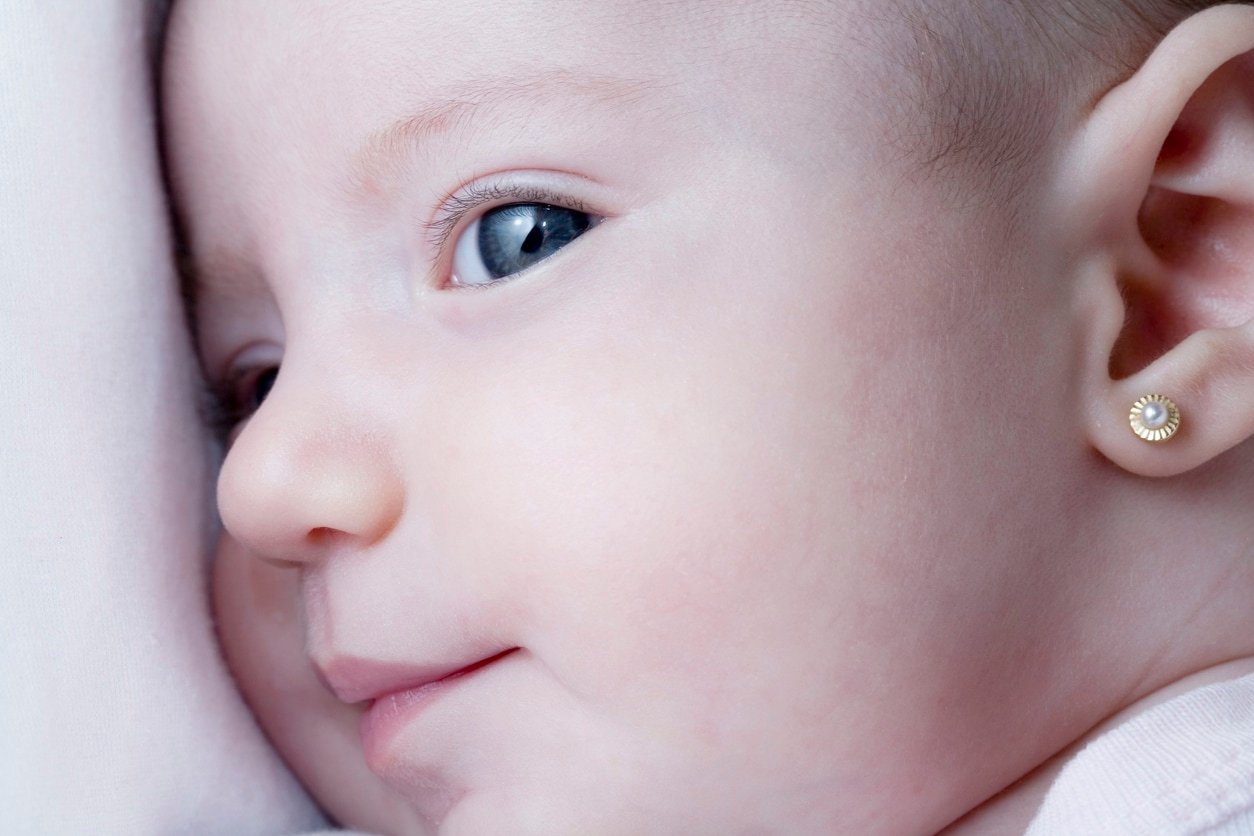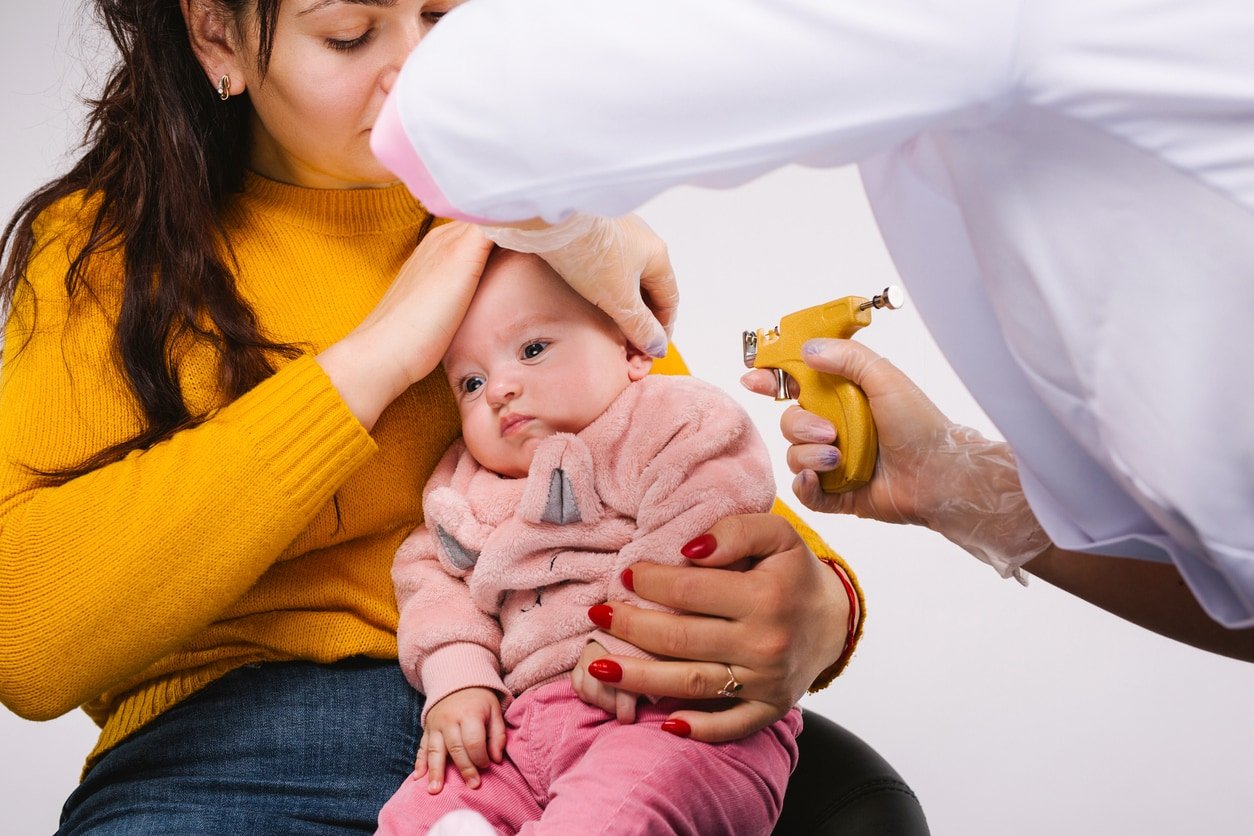
Historians believe the practice of ear piercing is over 5,000 years old. The first ear piercings arose for magical purposes, and while people today get their ears pierced for various reasons, the best time to get a piercing is hotly debated. The answer varies greatly depending on who you ask.1 If you’re considering piercing your baby’s ears, remember there’s more to consider than what sweet style of jewelry you select. Timing, health factors, and safety are pivotal in ensuring a smooth experience.
When Can Babies Get Their Ears Pierced?
The right age for a child to get their ears pierced can be tough, especially if you’re considering it for your baby or toddler who can’t express their preference. While some parents and experts suggest waiting until the child can consent, medical experts generally agree that piercing a baby’s ears is safe unless there are health concerns. Some doctors even suggest waiting until your little one has received two tetanus shots, usually around the age of 4 months.2,3
However, even with these considerations, the American Academy of Pediatrics (AAP) doesn’t offer a strict rule on the perfect timing for ear piercings. Although it recommends waiting until a child can manage aftercare themselves, it doesn’t discourage the idea of baby piercings. Notably, the AAP says piercings can be safe at any age, provided the process uses clean, sterile equipment and proper techniques.4
No matter what age you settle on for getting your little one’s ears pierced, consulting a professional is key. Research and seek advice from trusted friends, family, and even your pediatrician for referrals to reputable piercing artists or technicians. This will help ensure that your baby’s ear-piercing experience is safe and a memorable and enjoyable moment.
The Ear Piercing Process
If your pediatrician offers piercing services, that’s a plus, as the setting is usually sterile and secure. When choosing a jewelry store or tattoo studio, pick a well-known place with good hygiene. If you’re unsure of a store’s track record, you can check with the Better Business Bureau to ensure there’s no history of issues. While state laws and licensing rules differ, the person doing the piercing should have good training, rock a fresh pair of disposable gloves, and use thoroughly sterilized equipment. If any doubts arise, ask about their hygiene procedures.
It’s a great idea to make sure you understand the ear piercing process before you walk into a business with your baby. While piercing guns are widespread, the Association of Professional Piercers (APP) does not advise using piercing guns due to their non-disposable nature and the challenges in thoroughly cleaning all components after each use. Moreover, spring-loaded piercing guns have the potential to harm cartilage and tissue.5

The APP also points out that while gun piercing shops offer operator training, it often lacks standardization and may involve minimal activities like watching videos, reading instructions, or practicing on non-clients. Concerns have arisen that some establishments don’t teach employees about the risks of gun piercings, including handling complications and malfunctions.5
Safety First
Safety measures should be at the top of your list to ensure you protect your baby from potential health complications or exposure to infection, which is why it’s important to note that needle piercing performed by an experienced professional is typically safer than gun piercing.5
Once you’ve chosen a professional you’re comfortable with, ensure your little one is in good spirits before the piercing. Pick a relaxed time for you and your baby, and avoid bringing an overtired or hungry baby to the appointment. Be prepared to provide soothing, comforting cuddles during and after the piercing. Having a favorite stuffed animal or blanket on standby might also help — a few tears might be inevitable, even if the piercing takes seconds.
How Long Does a Baby’s Pierced Ears Take To Heal?
The healing journey for baby ear piercings can vary, influenced by skin sensitivity and individual traits. However, as a general guideline, you can expect your little one to heal in about four to six weeks. Parents and caregivers must adhere to proper aftercare instructions provided by the technician to steer clear of any infections or discomfort. This helps minimize the risk of potential medical complications.6
Taking Care of Your Baby’s Ear Piercing
When your baby first gets their ears pierced, leave the earrings in until their ears completely heal — remember that four to six-week window. If not, the holes could close up, and they’ll have to go through everything again. This is a process neither of you likely wants to relive.
You want to keep your baby’s ears extremely clean to avoid germs with freshly pierced ears, so medical professionals agree it’s essential to clean the ears and put ear cleaning solution, rubbing alcohol, or antibiotic ointment on them twice a day once the ears have healed.7
As a general best practice, follow these steps twice a day:7
- Wash hands thoroughly.
- Use a cotton swab to apply rubbing alcohol or antibiotic ointment to the earlobes.
- Gently rotate the earring in the ear.
- Using petroleum jelly, gently apply a thin coat around each opening.
Piercings are Open Wounds
Remember that newly pierced ears are small open wounds, so extra care is essential. While applying petroleum jelly, the American Academy of Dermatology Association suggests using a squeeze tube to prevent transferring germs from an open jar. Keeping the piercings moisturized with petroleum jelly aids in faster healing.8 Be cautious during clothing changes or hair brushing, and avoid contact with hairspray, shampoo, or perfumes to prevent irritation. If you can, avoid exposing your baby to swimming in pools, hot tubs, lakes, or oceans while their piercings are healing because this could increase the risk of infection.9
After your baby’s ears have healed, removing the earrings every night before bedtime is a good idea. If your baby’s earlobes are swollen, red, warm, or oozing a yellow-white fluid called pus, they may have an infection. In such cases, contact your pediatrician to avoid potential complications. Remember, infections can spread and even lead to fever if left untreated. If an infection arises, take a deep breath – with quick medical attention, regular cleaning, and antibacterial ointment, piercing infections can heal swiftly.10
What’s the Best Material for Starter Earrings?
Choosing the right material for your baby’s earrings is parental preference and your child’s comfort. However, certain metal alloys have earned approval for medical use, with specific designations determined by esteemed standards like the American Society for Testing and Materials Standard (ASTM) or the International Standards Organization (ISO), notes the APP.11
Meanwhile, historical materials like gold and obsidian have been popular piercing options for centuries. Opting for gold starter earrings, unless your baby has a gold allergy, can cause fewer infections and less swelling due to their posts. The APP also endorses titanium, niobium, and platinum as safe earring materials.11
When it comes to choosing infant or toddler earrings, the choices in design are vast and creative. However, experts advise opting for flat studs situated close to the earlobe. Consider everything your baby might inadvertently pull on with her ninja grip, from tempting iPhone cords to mom’s delicate postpartum hair. The last thing you want is an emergency trip to the doctor because your mini-hulk used her super-strength to rip her new jewelry out.2
As you venture into selecting your baby’s starter earrings, remember to keep three factors in mind:7
- Material: Opt for hypoallergenic options to minimize the risk of irritation.
- Size: Choose petite and lightweight earrings for enhanced comfort.
- Design: Prioritize earrings with screw-backs for added security and peace of mind.
A Glittering Start for Your Little One
If you initially believed piercing your baby’s ears was as easy as a spontaneous visit to the mall’s jewelry kiosk, hopefully, you now have the knowledge to make a good choice for your little darling. No matter when or how you embark on this journey, use the insights gathered here to ensure a safe and memorable experience for your family. By following these steps and keeping a watchful eye, you’ll ensure that your baby’s ear-piercing experience remains a positive and safe one.
from Baby Chick https://ift.tt/xC8X65Y
via IFTTT


0 Comments
Please ,
Don't enter span link ...